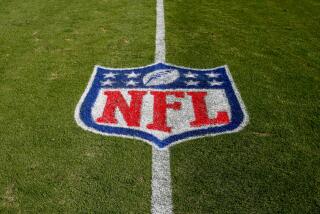Experts Face Off About Soccer Heading
- Share via
WASHINGTON — Like a loose ball in a kids’ game, argument over the safety of heading in soccer has parents, coaches and scientists scrambling all over.
Some youth soccer leagues, reacting to research that indicated players could get concussions, are setting rules to restrict striking the ball with the head. Doctors who authored a new review of research respond that the technique is safe. But another expert stands by his contention that heading is too risky for the young.
The scientists’ arguments leave nonscientists unsure where to stand.
“It’s almost a civil war, split down the middle, who likes it and who doesn’t,” said John E. Ouellette, coaching chief at the American Youth Soccer Organization. AYSO doesn’t forbid heading, but individual leagues can if they want to--and some do for players ages 10 and younger, he said. AYSO’s stand is that if players want to learn it, and the league allows it, the players should be taught proper form.
A key question is whether heading causes concussion. Athletes who receive repeated concussions can develop cognitive problems. And a 1999 report in the Journal of the American Medical Assn. found soccer players scored lower than other amateur athletes on tests of memory and planning ability. Researchers suspected that repeated blows to the head could have been the cause.
The possibility that heading the ball could affect the ability to think is enough to worry some young players’ parents. “Ninety-nine percent are moms who believe that, if it isn’t necessary, let’s not do it,” Ouellette said.
On the other hand, players who’ve watched an older sibling or a pro on TV head the ball want to do it too, Ouellette said.
And a new review of published studies casts doubt on the idea that heading the ball impaired cognition. Head injuries can result from many other causes, such as striking a goalpost or colliding with another player, said Donald T. Kirkendall of the University of North Carolina, Chapel Hill.
“It looks like the prime factor in these cognitive deficits has to do with a history of head injuries, as opposed to heading the ball,” said Kirkendall, a longtime soccer player and a member of the sports medicine committee in the United States Soccer Federation, the sport’s U.S. governing body. His article is in the May issue of the journal Sports Medicine.
Especially in youth games, the ball may not be going fast enough to create the force required to generate brain injury, Kirkendall said. And a properly executed header, striking the ball at the hairline while the neck muscles are tensed, lets the force of the ball diffuse with safety through the whole body instead of concentrating on the skull, he said.
The Consumer Product Safety Commission held a conference on the issue in May 2000 but did not take any action.
“Our staff says there still is debate on whether heading actually produces injury,” said CPSC spokeswoman Jane Francis. Studies to date haven’t decided it, she said.
But a separate researcher thinks the case for risk is compelling, at least in some players. Mariusz Ziejewski, an associate professor in neuroscience and a mechanical engineering specialist in impact biomechanics at North Dakota State University, fired soccer balls at crash test dummies to gauge the potential for injury.
“Those studies show a substantial motion of the head, sufficient to cause concussion” when the ball struck the side of the head, Ziejewski said. The skull, neck and brain are anatomically better able to absorb a blow from the front than the side, he said.
A well-trained soccer player executing a header with correct technique should have nothing to worry about, but the ill-prepared player could suffer, Ziejewski said. Ziejewski works with a company that makes protective headgear, but he said headgear only reduces risk and does not eliminate it.






